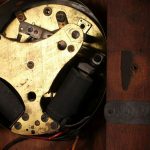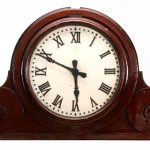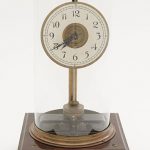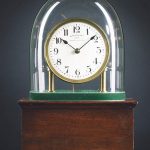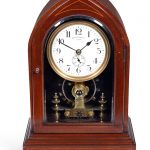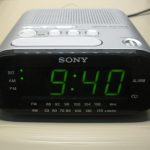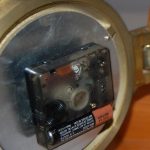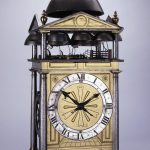Electric Clocks. An electric clock is a clock that is powered by electricity, as opposed to a mechanical clock which is powered by a hanging weight or a mainspring. The term is often applied to the electrically powered mechanical clocks that were used before quartz clocks were introduced in the 1980s. The first experimental electric clocks were constructed around 1840, but they were not widely manufactured until mains electric power became available in the 1890s. In the 1930s the synchronous electric clock replaced mechanical clocks as the most widely used type of clock. Reference: Wikipedia
Electric Clock Movement
A MONUMENTAL GALLERY CLOCK FORM B&O CAMDEN STATION
The 63-inch long wood frame with white dial and applied black Roman numerals, the wood case set with an electric slave clock movement, the circular dial case flanked by large ‘S’ scrolls, the Baltimore and Ohio Railroad station at Camden and Eutaw streets, the south end of Eutaw Street in Baltimore is near Oriole Park and Camden Yards where the Orioles play. Measures 30 x 63.25 x 9.5 inches.
Sold for $800 at Soulis Auctions in 2019
A battery powered electrical clock. Made 1918-1940 A radium battery powered, electrical, pendulum clock mounted on wooden base and covered by glass dome cover. The clock has a circular dial that consists of a brass backing plate and a silvered brass chapter ring. There are black numerals from ‘1’ to ’12’ around the edge of the chapter ring. The dial is mounted on a cylindrical brass stand that is fixed to the square wooden base. The battery box is incorporated into the wooden base and there is an on / off switch at the back on the outside of the box. The clock mechanism is exposed and can be seen at the back of the clock face.
Reference: Museum of Applied Art and Sciences
An English mahogany electric timepiece, Eureka circa 1920 enamel dial with Arabic numerals signed Eureka Clock Co Ltd 1000 days electric clock, brass electric movement with large vertical balance wheel on a mahogany base covered by a glass dome Height clock 28 cm
Sold for 947 EUR at Sotheby’s in 2003
An early 20th century mahogany and inlaid electric mantal clock signed Eureka Clock Co Ltd., London. Number 7341. the lancet shaped case with glazed front door over a line-inlaid plint on brass ball feet, the signed 4.25 inch cream enamel Arabic dial with running seconds at 6, the substantial balance visible below powered by a battery set into the base (requires battery), 38cms high
Sold for £ 1,500 inc. premium at Bonham’s in 2018
Digital radio alarm clock. (Sony “Dream Machine”, model number ICF-C218). The case is formed of silver plastic with a transparent dark tinted front panel. The clock and radio indicators are visible through the front panel. The speaker grille and controls relating to time and alarm setting are located on top of the clock. Controls for the radio are located on the right-hand side of the clock (as normally viewed). A captive mains power cable and the radio antenna emerge from the rear of the clock. The clock display is of green LED digital type. The digital display may indicated time, date or alarm time. Also indicated, by LED dots, are “DST” (daylight saving time, lit for yes), “ALARM” (alarm status, lit for on) and battery sysmbol (state of backup battery, lit for weak). The radio frequency indicator scale is located underneath the clock display and is of the linear mechanical type.
The clock is quartz controlled. It uses the Sony “Auto Time Set” system, whereby the time is preset at the factory, using a backup battery to retain time when clock is unplugged (although the time is not displayed when unplugged). The clock is not automatically regulated. The time and date can be adjusted by pressing the button marked “CLOCK” for 2 seconds, then using the “+” and “-” buttons. The clock automatically adjusts for British Summer Time.
The alarm can be set to use radio or buzzer and has a variable snooze feture. The radio has FM and AM bands. Tuning and volume adjustment is carried out using rotary controls at the side of the clock.
Reference: © The Trustees of the British Museum
